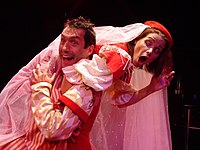Role in the play
Katherina Minola is the older daughter of Baptista Minola and the sister of Bianca. Many men have deemed Kate to be a poor option for marriage as she does not fit within the societal standards of what a good wife should be. Baptista also declares that Bianca may not marry until Kate has been married, which causes some outrage and plotting from Bianca's suitors. It is this declaration from Baptista that drives Petruchio to want to wed Kate, he is encouraged by Hortensio (who wants to wed Bianca). In the first encounter between Kate and Petruchio, Petruchio manages to match Kate's temper and convinces her father that she loves him but only pretends to hate him. Kate stays surprisingly quiet when Petruchio declares they will be married the following Sunday. The silence from Kate and Petruchio's words are enough for Baptista and the two are wed; though Petruchio arrives late and forces Kate to leave the wedding feast early.
Now at this point, Petruchio attempts to "tame" Kate in several ways. Kate is frightened by the way that Petruchio yells at his servants, she is kept from sleeping and eating, with Petruchio saying that each dish brought is not good enough for her. She is told several times by him that because he loves her so much, he cannot let her have such substandard food or sleeping conditions.
On the way to Padua to visit Baptista, Kate is further humiliated and broken down as Petruchio forces her to say that the sun is the moon, and that an old man is a beautiful woman. Kate's will has mostly been broken down by this point, likely due to the lack of food and rest. She therefore agrees entirely with everything her husband says. The two embrace and continue on to Padua, where Bianca and Lucentio announce they are to be married.
At the wedding feast of Bianca and Lucentio, Kate, Bianca, and "the widow" who is married to Hortensio are each called by their husbands in a competition to see who has the most obedient wife. Kate is the only one who comes and she then brings the other two women in on orders from Petruchio. Kate then gives a speech instructing the women to listen to their husbands.
There is a very clear sibling rivalry between Bianca and Kate. Kate at one point accuses Bianca of being their father's "treasure" and the one that he wishes to have married first. In Act II Scene I, Kate ties Bianca's hands and whips her as she is attempting to discover which of the suitors Bianca likes best.
This page is based on this
Wikipedia article Text is available under the
CC BY-SA 4.0 license; additional terms may apply.
Images, videos and audio are available under their respective licenses.

